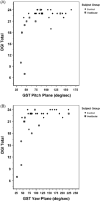Gaze stabilization and gait performance in vestibular dysfunction
- PMID: 18815040
- PMCID: PMC4879829
- DOI: 10.1016/j.gaitpost.2008.08.002
Gaze stabilization and gait performance in vestibular dysfunction
Abstract
Background: The gaze stability test (GST) quantifies the ability of a person to recognize a target projected on a personal computer monitor during active head movement.
Purpose: The purpose of this study was to determine if there was a relationship between clinical measures of walking performance and the GST in patients with vestibular disorders and in healthy subjects. We hypothesized that impairment of the ability to keep objects in focus during active head movement would be correlated with walking performance.
Subjects: Twenty older asymptomatic adults acted as controls and 12 patients with either unilateral or bilateral vestibular disease participated.
Methods: The GST quantifies the maximum velocity that a person can move their head in the pitch and yaw planes while retaining the ability to read an optotype that is momentarily projected onto a computer screen. Subjects were scored while performing the Dynamic Gait Index (DGI) and the Timed "Up & Go" (TUG) tests.
Results: Walking performance on the DGI and TUG were significantly associated with GST results in subjects with vestibular disorders, but not in control subjects. Abnormalities of gait could be identified by GST cutoff values of 65 degrees s(-1) in the pitch plane and 63 degrees s(-1) in the yaw plane.
Discussion/conclusion: In older subjects with vestibular disorders, gaze stability, as assessed by the GST, is associated with reduced test scores on measures of gait performance.
Conflict of interest statement
All authors have participated in the study and contributed to the preparation of the manuscript. The paper has not been submitted to any other journal for review.
Figures


References
-
- Leigh RJ, Zee DS. The neurology of eye movements. Oxford University Press; New York: 1999.
-
- Maas EF, Huebner WP, Seidman SH, Leigh RJ. Behavior of human horizontal vestibulo-ocular reflex in response to high-acceleration stimuli. Brain Res. 1989;499:153–6. - PubMed
-
- Grossman GE, Leigh RJ, Bruce EN, Huebner WP, Lanska DJ. Performance of the human vestibuloocular reflex during locomotion. J Neurophysiol. 1989;62:264–72. - PubMed
-
- Hess K, Gresty M, Leech J. Clinical and theoretical aspects of head movement dependent oscillopsia (hmdo). A review. J Neurol. 1978;219:151–7. - PubMed
-
- Schubert MC, Minor LB. Vestibulo-ocular physiology underlying vestibular hypofunction. Phys Ther. 2004;84:373–85. - PubMed
Publication types
MeSH terms
Grants and funding
LinkOut - more resources
Full Text Sources
Research Materials

